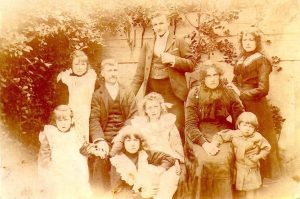
Introduction to DNA Testing for Genealogy
DNA testing for genealogy Family history groups and societies have been abuzz with excitement over recent years, as DNA testing becomes mainstream for genealogists, and
Nebula Genomics is a Whole Genome Sequencing (WGS) test. Whole genome sequencing reads 6.4 billion locations in your genome, which is approximately 10,000 times more than the number of markers tested in our genealogy DNA tests. Each location of your genome is read 30 times, which results in high accuracy.
After five years of using DNA testing for genealogy, my interest in whole genome sequencing was piqued in 2016 when I completed the free Future Learn couse Whole Genome Sequencing: Decoding the Language of Life and Health. At about the same time, an Australian startup company was pre-selling WGS tests, so I ordered one and waited excitedly, but unfortunately their venture never got off the ground and monies were refunded.
In the following years, more whole genome sequencing tests came on the market, but were not available to customers outside the US. Then came Nebula Genomics – which is now available in 188 countries – so from Australia I can finally purchase one!
I was recently offered a discounted test if I reviewed the product, so I decided to give it a go and share my experience with you along the way.
What about my genealogy?
Although the focus of the Nebula Genomics whole genome sequencing test is to learn about yourself and your health, your Nebula results include sequencing of your Y-DNA and mitochondrial DNA genomes, and Nebula enables easy transfer of your DNA data to Family Tree DNA for further analysis and matching to relatives in Family Tree DNA’s database.
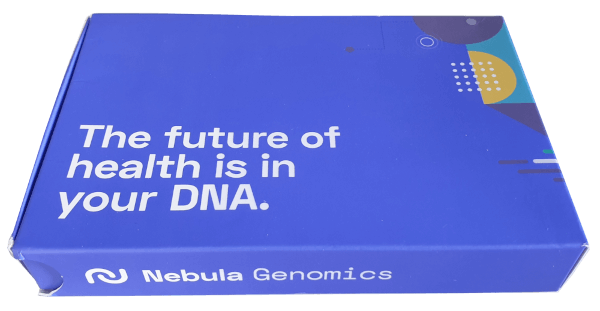
After reading the information on Nebula Genomics home page and other pages (including FAQ) to learn more about the product, I clicked on Get Sequenced and a simple one-page cart opened. I added my email address, payment information, selected reporting options, then clicked to pay and my order was confirmed!
Nebula offers free shipping worldwide!
After ordering, I received a USPS tracking code, enabling me to monitor my kit’s travels through various states in the US, then to Sydney. Once it arrived in Sydney, the USPS tracking ended, but the same tracking code worked with Australia Post, so I knew on the morning of arrival that it would be delivered that day. My kit took three weeks to arrive, which is very good for international shipping in COVID-19 times.

The bright purply-blue box contained a simple DNA collection kit, as pictured above. Two sterile collection swabs (similar to cotton-buds/Q-tips), a small plastic collection vial containing a preservative liquid, a plastic specimen pouch to keep it secure on its return travels, a step-by-step instruction sheet, and a small yellow padded envelope.
Sample collection proved easy, as I followed the step-by-step instruction sheet and diagrams. I opened the packet ends of the two sterile swabs, rubbed and rolled one swab on the inside of one cheek for 60 seconds, immersed the swab into the vial and swished it up and down to disperse the DNA into the liquid, then extracted and discarded the swab. I repeated the process with the second swab on the other cheek, then I tightened the vial lid and was done! This YouTube video demonstrates how easy DNA collection is.
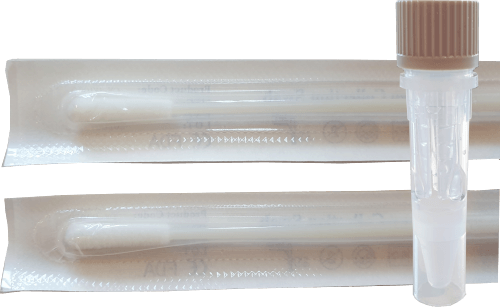
Ensure one of the Kit ID Number stickers is secured on the outside of the vial.
The other sticker is on the instruction sheet, as a backup copy of the Kit ID Number, so keep the instruction sheet handy for registration.
Place the vial into the plastic specimen bag, seal it and put it into the yellow padded envelope.
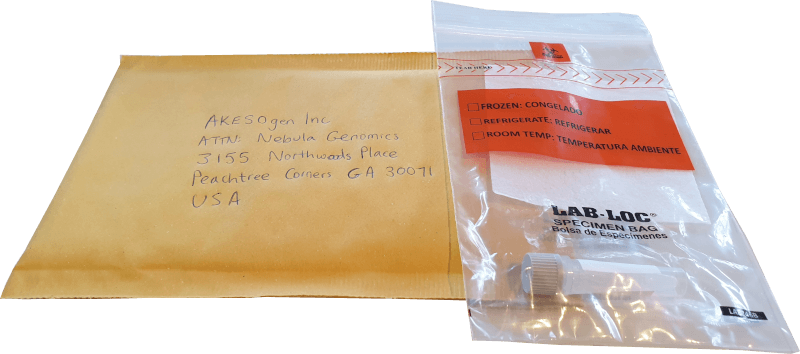
Take the little yellow padded envelope (containing your DNA sample) to your post office, and complete a customs form. In Australia, you can now complete the customs declaration online beforehand, then once you are at the post office just show the QR code or confirmation number on your smartphone or printed, and it will be retrieved automatically. Your envelope must be sent as a parcel, which costs A$21 for an international parcel from Australia to the US. Tracking information will be emailed to you at each stage of your kit’s return journey and upon its arrival at the destination.
When you do a DNA test you must register your kit online, which links your DNA sample to your online account, otherwise they won’t know whose sample it is to give the results to.
As you can see from Nebula’s Kit Registration page below, it was very straightforward.
I just had to enter my email address, create a password, and enter the Kit ID Number (printed on the sticker on the vial and on the instruction sheet) and click Submit.
All I had to do after that was verify my email address by clicking on the link in the email that had already arrived, which took a few seconds, then I could log in to my new account.
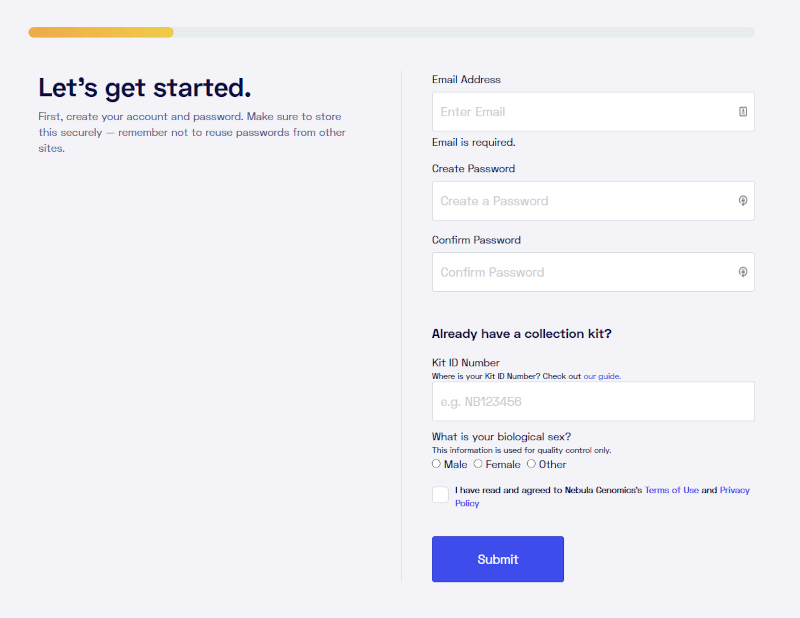
Well, this is only the first part of my experience with Nebula Genomics.
I have to wait – probably a few months – for my sample to be shipped and processed and to receive my results in my online account. Then I will be able to explore my results, view the range of reports and options available, and download my data files in various formats (if desired).
I can already login to my Nebula Genomics account and start answering surveys and exploring their genetic research library of genetic conditions.
I look forward to learning about genetic traits such as appearance and hormones, behaviour and perception, body and athleticism, and nutrition and diet, and to receiving new reports each week, based on the latest scientific discoveries.
Watch this space as I add to my Nebula Genomics experience and story!
After posting, my Nebula sample took two weeks to arrive at Nebula in the USA – which was very good for Covid-19 era postage times!
Three weeks after my sample arrived at the lab, I received notification that it has entered quality control to ensure data quality and sufficient DNA. If it passes QC, it will be sequenced – which will take approximately 6 weeks – and then I will receive an email indicating that my results are ready.
Update: My results were ready 11 weeks later, and at first look they appear very detailed. I need to spend time reviewing all the reports and information.
Explore your genes with Nebula Genomics whole genome sequencing too!

DNA testing for genealogy Family history groups and societies have been abuzz with excitement over recent years, as DNA testing becomes mainstream for genealogists, and
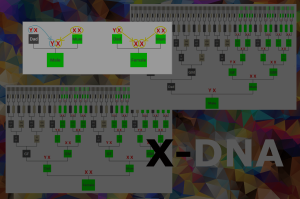
X-DNA’s helpful inheritance patterns When you test your autosomal DNA at any of the five genealogy DNA testing companies (ie. Ancestry, 23andMe, MyHeritage, Family Tree

Autosomal DNA finds matches on all ancestral lines Everyone inherits autosomal DNA from their parents: 50% from each parent, which contains a random mix of
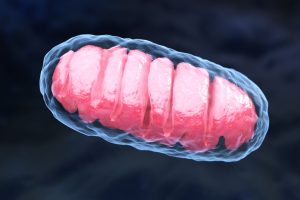
Mitochondrial DNA – the direct maternal line Everyone inherits mitochondrial DNA (mtDNA) from their mother – through her mother, her mother, her mother, her mother,
2 Responses
Can you provide more information about your custom form? Did you declare it as a DNA sample? I have to go similar steps posting from NZ.
Hi Svetlana, You need to describe “what it is and what it is made of” accurately, as it may be opened for inspection. I submitted the online customs form, and I wrote “1 x tiny plastic vial containing a bit of spit” (as it is not DNA data until after it is processed). I don’t seem to have retained the ‘reason I am sending the parcel’, but I probably wrote something like “processing for genealogy research and to determine ancestral origins”. Good luck! Cheers, Louise